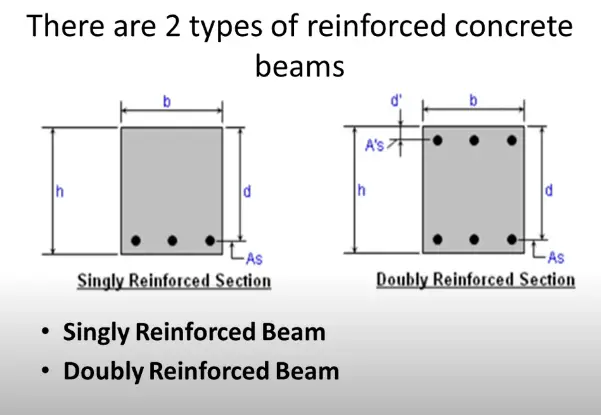Singly Reinforced Beam and Doubly Reinforced Beam
Singly Reinforced Beam and Doubly Reinforced Beam
What is a Beam?
Beams are primarily applied to flexure or bending and frequently support slabs. Beams bear the loads imposed by slabs as well as their own weight via internal moments and shears.
What are Reinforced concrete beams
Reinforced concrete beams are structural component used to support transverse external loads. Across their length, the loads generate bending moments, shear forces, and, in some circumstances, torsion.
Furthermore, concrete is incredibly strong in compression but very weak in tension. Steel reinforcement was therefore used to absorb tensile stresses in reinforced concrete beams. Beams also support loads from slabs, other beams, walls, and columns.
They distribute the loads to the columns that support them. Beams can also be simply supported, continuous, or cantilevered. They can have rectangular, square, T-shaped, or L-shaped parts. Beams can be single- or double-reinforced. If the depth of the beam is limited, the latter is used.
Singly Reinforced Beam and Doubly Reinforced Beam
A single reinforced rectangular beam is a reinforced concrete beam with a rectangular cross-section that has reinforcement solely in the tension zone.
A double reinforced rectangular beam is a reinforced concrete beam with a rectangular cross-section that has reinforcement both in the tension zone as well as compression zone.
Singly Reinforced Beam Design Example
A single reinforced beam is a concrete beam with only one tension zone of cross-section area covered with steel rod.
Doubly Reinforced Beam Design
A doubly reinforced beam is a concrete beam that is reinforced with steel in both the tension and compression zones. This sort of beam is typically used when the depth of the beam is limited.
If a beam with limited depth is reinforced exclusively on the tension side, it may not have enough resistance to resist the bending moment.
For specific grades of steel and concrete, doubly reinforced beams have a greater moment of resistance than singly reinforced beams of the same depth. Architectural or functional factors may limit the overall depth of the beams in many practical circumstances. Except in doubly reinforced beams, compression steel reinforcement is used when some sections of a continuous beam with moving loads experience a change in the sign of the bending moments.
What are Tension and Compression Forces in Reinforced Concrete?
Tension and compression forces are the forces exerted within a structure, in normal tension and compression respectively.
These forces are most often seen in structures such as reinforced concrete where they are needed to balance out the tensile and compressive forces that naturally arise due to the stress at each point in the structure.
These forces help make the structure more stable and even reduce the overall stresses in the structure, thus extending its lifespan.
In reinforced concrete structures, tensile force refers to a force in a straight line along the length of the slab, just like a rope being pulled in a tug-of-war.
When an external force (such as gravity) is applied to a reinforced concrete structure, there always exists forces in both tensile and compression.
The magnitude and direction of the tensile force is directly proportional to the magnitude and the direction of the applied external force.
The magnitude and direction of the compression force is inversely proportional to that of the tensile force: when the tensile force becomes greater, the compression force becomes smaller and vice versa.
This is due to the reinforcing bars (rebars) which are positioned perpendicular to the supporting forces.
Making sure that the reaction to these forces is minimized and has no detrimental effect on the columns is one of the most important design considerations in reinforced concrete structures.
The idea of designing a structure using the minimum amount of reinforcement to prevent any slip and movement due to these tensile and compressive forces is called redundancy.

